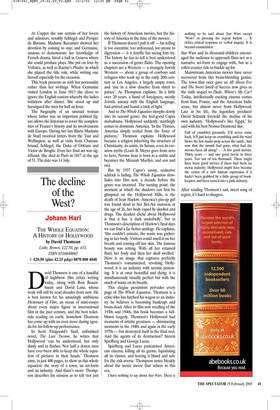The decline of the West?
Johann Hari
THE WHOLE EQUATION: A HISTORY OF HOLLYWOOD by David Thomson Little, Brown, £22.50, pp. 433, ISBN 0316848603 ✆ £20.50 (plus £2.25 p&p) 0870 800 4848 David Thomson is one of a handful of highbrow film critics writing today, along with Ron Rosenbaum and David Lane, whose work will still be read decades from now. He is best known for his amazingly ambitious Dictionary of Film, an ocean of mini-essays about every major figure in international film in the past century, and the best toiletside reading on earth. Somehow Thomson has come up with an even more daring agenda for his follow-up performance.
In Scott Fitzgerald’s final, unfinished novel, The Last Tycoon, he writes that Hollywood ‘can be understood, but only dimly and in flashes. Not half a dozen men have ever been able to keep the whole equation of pictures in their heads.’ Thomson aims, in just 400 pages, to show us this whole equation: the story of a town, an art-form and an industry. And there’s more: Thompson describes his mission as to tell ‘not just the history of American movies, but the history of America in the time of the movies’.
If Thomson doesn’t pull it off — his telling is too eccentric, too unfocused, too prone to digression — it is terrific fun seeing him try. The history he has to tell is best understood as a succession of genre flicks. The opening chapters are a Western — a strangely Jewish Western — about a group of cowboys and refugees who wash up in the early 20th century in Los Angeles, a largely empty town, and ‘rise in a slow dissolve from shtetl to palace’. As Thompson explains, ‘In a little over 20 years, a band of foreigners, mostly Jewish, uneasy with the English language, had arrived and found a trick of light.’ And so The Whole Equation morphs slowly into its second genre: the feel-good Capra melodrama. Hollywood suddenly, startlingly comes to dominate America. ‘In the Thirties, America simply reeled from the force of pictures,’ Thomson explains. Hollywood became a religion inheriting the structure of Christianity, its saints, its Satans, even its creation myths (Louis B. Meyer goes from zero to hero, Norma Jean is born in a stable and becomes the Messiah Marilyn, and son and on).
But by 1937 Capra’s sunny, seductive schlock is fading. The Whole Equation slowfades into film noir, a decade before the genre was invented. The turning point, the moment at which the shadows can first be glimpsed on the Hollywood Hills, is the death of Jean Harlow. America’s pin-up girl was found dead in her Bel-Air mansion at the age of 26, her body raped by alcohol and drugs. The deadest cliché about Hollywood is that it has ‘a dark underbelly’, but in Thomson’s description of Harlow’s final days we can find a far better analogy. He explains, ‘She couldn’t urinate; the waste was gathering in her body. Visitors could smell it on her breath and coming off her skin. The famous beauty was rotting. With all her retained fluid, her body and then her skull swelled.’ Here is an image that captures perfectly Thomson’s romanticised, revolting Hollywood: it is an industry with uremic poisoning. It is at once beautiful and dying; it is simultaneously visually perfect but with the smell of waste on its breath.
This elegiac pessimism pervades every page of The Whole Equation. Thomson is a critic who has hitched his wagon to an industry he believes is becoming bankrupt and brain-dead. After its film noir retelling of the 1930s and 1940s, this book becomes a fullblown tragedy. Thomson’s Hollywood had moments of artistic greatness — shimmering moments in the 1940s and again in the early 1970s — but destroyed itself in the final reel. And the agents of its destruction? Steven Spielberg and George Lucas.
Spielberg and Lucas pasteurised American cinema, killing all its germs, liquidating all its viruses, and leaving it bland and safe for the risk-averse. Thompson notes bleakly about the iconic movie that ushers in this era, I have nothing to say about Star Wars. There is nothing to be said about Star Wars except ‘Wow!’ or pressing the repeat button ... It defies critical response or verbal inquiry. It is beyond examination.
Star Wars and its thousand children encouraged the audience to approach films not as a narrative art-form to engage with, but as a roller-coaster ride to buckle up for.
Mainstream American movies have never recovered from this brain-blending genius. The town that once gave us All About Eve and The Sweet Smell of Success now gives us the sixth sequel to Dude, Where’s My Car? Today, intellectually exciting cinema comes from Iran, France, and the American Indie scene, but almost never from Hollywood. Late in his life, the legendary producer David Selznick foretold the decline of his own industry. ‘Hollywood’s like Egypt,’ he said with his best Norma Desmond slur.
Full of crumbled pyramids. It’ll never come back. It’ll just keep on crumbling until the wind blows the last studio prop across the sands. And now that the tumult had gone, what had the movies been all along? ... A few good movies. Thirty years — and one good movie in three years. Ten out of ten thousand. There might have been good movies if there had been no movie industry. Hollywood might have become the centre of a new human expression if it hadn’t been grabbed by a little group of bookkeepers and been turned into a junk industry.
After reading Thomson’s sad, sweet song of regret, it’s hard to disagree.

















































 Previous page
Previous page